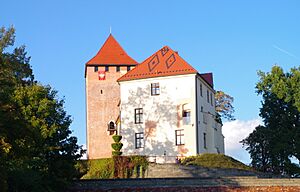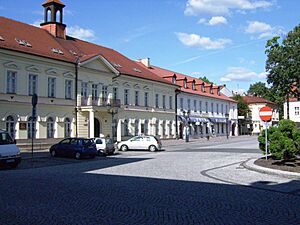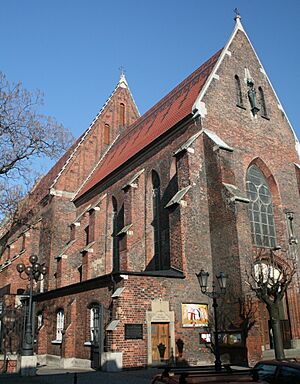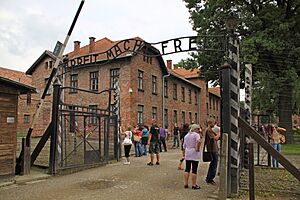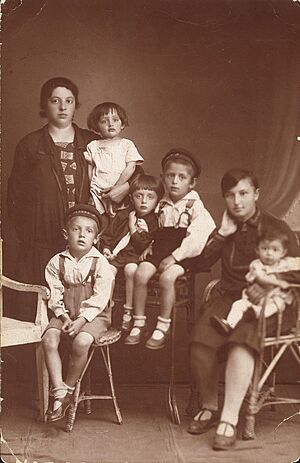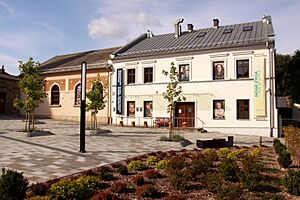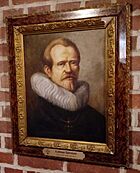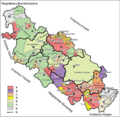Oświęcim facts for kids
Quick facts for kids
Oświęcim
|
|||
|---|---|---|---|
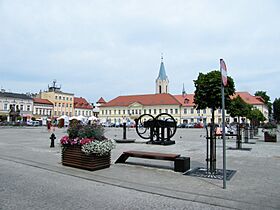
Old Market Square
|
|||
|
|||
| Country | |||
| Voivodeship | |||
| County | Oświęcim | ||
| Gmina | Oświęcim (urban gmina) |
||
| Established | First mentioned in 1117 | ||
| City rights | 1291 | ||
| Area | |||
| • Total | 30.3 km2 (11.7 sq mi) | ||
| Elevation | 230 m (750 ft) | ||
| Population
(2023)
|
|||
| • Total | 34,170 | ||
| • Density | 1,127.7/km2 (2,921/sq mi) | ||
| Time zone | UTC+1 (CET) | ||
| • Summer (DST) | UTC+2 (CEST) | ||
| Postal code |
32–600, 32–601, 32–602, 32–603, 32–606, 32–610
|
||
| Area code(s) | +48 033 | ||
| Car plates | KOS | ||
| Website | Oświęcim | ||
Oświęcim (pronounced osh-VYEN-chim) is a town in southern Poland. It's located in the Lesser Poland region, about 33 kilometers (20 miles) southeast of Katowice. The town sits near where the Vistula and Soła rivers meet. Oświęcim is known worldwide because it was the location of the Auschwitz concentration camp, built by Nazi Germany during World War II.
Contents
What's in a Name? The History of Oświęcim's Name
The name Oświęcim comes from Polish or Slavic languages. It might have come from the owner of an old Slavic fort that was here in the Middle Ages. Over time, the town's name has been spelled in many different ways. These include Oswenin (in 1217), Osvencin (in 1280), and Osswetem (in 1290).
In the 14th century, German traders called it Auswintz. By the 15th century, this became Auschwitz. From 1772 to 1918, Oświęcim was part of the Habsburg monarchy (the Austrian Empire). Both Polish and German names were used officially. During World War II, when Nazi Germany took over Poland, the town was called Auschwitz. It became Oświęcim again on January 27, 1945, after the Red Army pushed out the German army.
Where is Oświęcim? Geography and Travel
Oświęcim is located where several main roads meet. The old part of town is east of the Soła river, with the Main Market Square in the middle. The train station is across the river, in the northwest part of town.
The Auschwitz-Birkenau State Museum is in a nearby village called Brzezinka. You can find the main bus station in the eastern part of town. Train services connect Oświęcim to cities like Kraków and Katowice in Poland. You can also travel internationally to places like Vienna and Prague. The closest airport is about 60 kilometers (37 miles) away, near Kraków.
Oświęcim's Weather
Oświęcim has four clear seasons: spring, summer, autumn, and winter. It gets a good amount of rain, especially in spring and summer. Summers are warm and humid, but often cloudy. Winters are cold and windy, with snow. Fog is very common throughout the year and is a well-known feature of the town.
A Look Back: Oświęcim's History
Oświęcim has a very long history, going back to the early days of Poland. It was one of Poland's oldest fortified settlements. In 1179, it became part of the Duchy of Opole. The town was destroyed in 1241 during the First Mongol invasion of Poland.
Around 1272, the rebuilt Oświęcim was given city rights. This was based on the Magdeburg Law, which was a common way to organize towns in Europe. In 1315, Oświęcim became an independent duchy. In 1327, it became a vassal state of the Kingdom of Bohemia for over 100 years.
In 1457, the Polish King Casimir IV Jagiellon bought the rights to Oświęcim. In 1564, the Duchy of Oświęcim officially became part of the Kingdom of Poland. It was added to the Kraków Voivodeship. Before this, Oświęcim had a lot of freedom within Poland. The town later became an important center for Jewish culture in Poland.
Like other towns in Lesser Poland, Oświęcim thrived during the Polish Golden Age. This good time ended in 1655 when Sweden invaded Poland. Oświęcim was burned, and the town declined. In 1772, it was taken over by the Habsburg Empire (Austria). It remained under Austrian rule until 1918.
In the late 1800s, Oświęcim became an important train hub. The town also suffered from several large fires. For example, in 1863, two-thirds of Oświęcim burned down. This included the town hall and two synagogues. After World War I, Oświęcim became part of the newly independent Second Polish Republic.
World War II and Its Impact
Before World War II, about 8,000 Jewish people lived in Oświęcim. This was less than half of the town's population. In October 1939, Nazi Germany took over the area.
In 1940, Nazi Germany began building the Auschwitz concentration camp near the town. They also built a large chemical factory. Polish residents in several areas were forced to leave their homes. The Germans wanted to create a large empty zone around the camp. About 17,000 people from Oświęcim and nearby villages had to leave. Eight villages were completely removed from maps. By April 1941, Oświęcim's population had shrunk to 7,600.
The Soviet Red Army entered the town and freed the camp on January 27, 1945. After the war, new housing was built in Oświęcim. The chemical industry became the main employer. Today, visits to the concentration camp memorial sites bring a lot of income to the town.
In 1979, Pope John Paul II visited Oświęcim. Later, in 2006, Pope Benedict XVI also visited the town.
Culture and Language
Oświęcim is culturally considered part of Upper Silesia. Some geographers even used the name 'Oświęcim Silesia'. This connection led to the town being directly taken over by Nazi Germany during World War II.
Oświęcim is also seen as the eastern edge of the Silesian language area. The way people speak Silesian in Oświęcim is influenced by the Lesser Poland dialect. It has special features that make it different from other Silesian and Polish dialects.
Sports in Oświęcim
Oświęcim has a well-known sports club called KS Unia Oświęcim, started in 1946. It used to have many different sports teams. Now, it's split into several clubs for specific sports.
- TH Unia Oświęcim is the ice hockey team. They have won the Polish championship 8 times!
- UKŁF Unia Oświęcim is for figure skating.
- Zasole-Unia Oświęcim is the football (soccer) club.
Another old sports club is KS Soła Oświęcim, a football club founded in 1919.
Famous People from Oświęcim

Many notable people come from Oświęcim, including:
- Łukasz Górnicki (1527–1603), a Polish poet and writer from the Renaissance period.
- Tadeusz Makowski (1882-1932), a Polish painter who worked in France.
- Shimson Kleuger (1925–2000), known as "The Last Jew in Auschwitz."
- Beata Szydło (born 1963), who served as the Prime Minister of Poland.
- Piotr Gruszka (born 1977), a famous volleyball player and world champion.
- Paweł Korzeniowski (born 1985), a well-known swimmer.
Town Partnerships: International Friends
Oświęcim is twinned with several towns and cities around the world. This means they have special friendly relationships and often share cultural exchanges.
|
Images for kids
See also
 In Spanish: Oświęcim para niños
In Spanish: Oświęcim para niños




